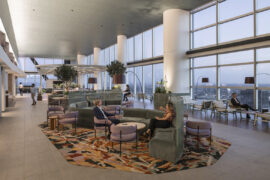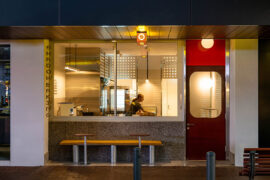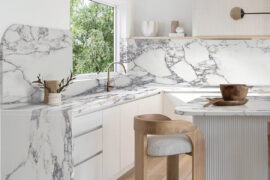Renaissance Tours is partnering with the Art Gallery of NSW for their Word Art Tours program, with Anthony Burke set to lead a visit to the USA.

August 16th, 2024
Art, architecture and travel: what could be better? The desirability of Renaissance Tours’ World Art Tours is one thing, and doubtless it won’t take much persuasion to convince you of that. However, I spoke to Anthony Burke – UTS Professor of Architecture and presenter of ABC shows Grand Designs Transformations, Restoration Australia and Grand Designs Australia – about what it means to really experience architecture. Can we ever do it justice from photographs, drawings or – dare I say – words? What’s the point of travelling across the world to see buildings in-person? Why, in short, does Burke do it?
This program of tours is delivered in partnership with the Art Gallery of New South Wales, with Burke leading a visit to the US in September. Architecture and the American Century will head to Chicago, Pittsburgh and New York to take in the work of Frank Lloyd Wright, Mies van der Rohe and others.

“When I went with students, it was from more of a history/theory point of view,” says Burke. “What I’m most excited by in this particular trip is that it feels like you’re in America at a time when so much is about to change. To be in that context [of the presidential election] and then look at some of the things that have set up the social-cultural landscape there is going to add another level of interest on top of everything else.”
Architecture being perhaps the spatial, tangible, physical art par excellence, it seems in some ways a truism to say that experiencing the real thing is the best option. Burke offers some deeper insights into why this might be the case, outlining three key reasons in particular.

First, the sheer physical-ness of it. You can touch a building, see it with your own eyes in a particular light: “I still firmly believe,” he says, “that you have to meet architecture face-to-face to really start to understand it.”
Second, the opportunity to understand the crucial context that is so often denied when viewing carefully curated photographs or deviously edited articles by architectural writers (not me, of course) – think surrounding landscape or neighbouring buildings, for example.
Third, Burke explains how the direct experience of architecture carries a certain egalitarian or democratic potential – instead of taking written, drawn or photographed presentation as true, a visit allows the individual to form their own personal judgement.
Related: Peter Zumthor’s thermal baths at Vals

“You’re looking to weigh up the official version of events against your own experience of the place, and that’s a very empowering and fortunate thing to be able to do – to start to formulate your own criteria for judgement and your own understanding of the values you might bring to a project. There’s also something about the looseness of going to see something face-to-face which is good; you’re really at the mercy of who’s there on the day, the weather, how transport was and so on – all these things colour your experience,” says Burke.
It’s clear that education is important dimension for these tours, but nor is it the whole story. What seems most important and lasting is an almost phenomenological point about experience. “You just can’t describe a building like Chichu Art Museum in Naoshima [by Tadao Ando] without going through it – it’s a building that makes zero sense in plan or as a drawing, but when you walk through it, the whole thing lights up as this amazing architectural promenade,” says Burke.

Some buildings, notes Burke, “just refuse” to be captured through modes of representation. ‘Media’ is, after all, the opposite of im-mediate, and architecture is its very own medium that demands encounter on its own terms. Perhaps what an architectural tour offers above all else is an opportunity to experience a building more directly.
So why, you might wonder, bother going on an organised tour when you could go and do the experiencing all by yourself? Well, a serious and sober layer of organisation forms the foundations upon which the meditative architectural promenades are built, so to speak. Logistical planning is of course crucial to a tour’s success – trust me, I’ve seen the exciting itinerary – but Burke also explains why it’s about so much more than mundane practicalities.

Often, it’s the space between people in a group setting that allows for the sharing of impressions and discussions about personal experience, encouraging the kind of judgement mentioned earlier. “Some of the best conversations I’ve ever had about architecture have been with students while you’re on bus between project visits, sitting on the subway, or having a glass of wine at the hotel afterwards,” he adds.
“It’s easy to google the facts and figures; in fact, you can do it while you’re standing in front of a building. But the things that really bring these buildings to life are the kind of human stories that sit around in the background – the homeowner or client, for example, or architect and the headspace were in, the context they were working through,” says Burke, who points to the story of architect-client relations in the famous Fallingwater house by Frank Lloyd Wright as an example.
There’s so much more to say, but I suppose you’ll just have to join the tour to hear it.
Renaissance Tours
renaissancetours.com.au
Art Gallery NSW
artgallery.nsw.gov.au







INDESIGN is on instagram
Follow @indesignlive
A searchable and comprehensive guide for specifying leading products and their suppliers
Keep up to date with the latest and greatest from our industry BFF's!

For a closer look behind the creative process, watch this video interview with Sebastian Nash, where he explores the making of King Living’s textile range – from fibre choices to design intent.

From the spark of an idea on the page to the launch of new pieces in a showroom is a journey every aspiring industrial and furnishing designer imagines making.

Designed by Woods Bagot, the new fit-out of a major resources company transforms 40,000-square-metres across 19 levels into interconnected villages that celebrate Western Australia’s diverse terrain.

In an industry where design intent is often diluted by value management and procurement pressures, Klaro Industrial Design positions manufacturing as a creative ally – allowing commercial interior designers to deliver unique pieces aligned to the project’s original vision.

Working within a narrow, linear tenancy, Sans Arc has reconfigured the traditional circulation pathway, giving customers a front row seat to the theatre of Shadow Baking.

At the Munarra Centre for Regional Excellence on Yorta Yorta Country in Victoria, ARM Architecture and Milliken use PrintWorks™ technology to translate First Nations narratives into a layered, community-led floorscape.
The internet never sleeps! Here's the stuff you might have missed

Working within a narrow, linear tenancy, Sans Arc has reconfigured the traditional circulation pathway, giving customers a front row seat to the theatre of Shadow Baking.

In creating interior spaces that enhance the wellbeing and experience of people, true responsible sourcing also considers the impact of materials and making.